View in other NatureServe Network Field Guides
NatureServe
Montana
Utah
Wyoming
Idaho
Wisconsin
British Columbia
South Carolina
Yukon
California
New York
Lake Whitefish - Coregonus clupeaformis
State Rank Reason (see State Rank above)
Species is native within a very limited area and few if any records exist within its native range. Threats and trends are unknown.
General Description
The lake whitefish is the largest of our four whitefish species. They commonly weigh 2 to 4 pounds, and the state record is 10 pounds. The lake whitefish has a deep, flat-sided body and is found mainly in the depths of clear, cold lakes across northwest and north-central Montana. All Montana whitefish are fall spawners. Adult lake whitefish move into the shore zone to broadcast their spawn randomly over a rocky bottom. Lake whitefish are schooling cold-water fishes and feed at depths often over 200 feet on plankton and other invertebrates. The lake whitefish is the most valuable commercial freshwater fish in Canada, but in Montana it is just beginning to catch on as a game fish in the Flathead Lake area.
Diagnostic Characteristics
Silvery, with olive to light brown back. This is the only Montana whitefish that does not have a distinct notch below pupil in membrane surrounding eye.
Species Range
Montana Range
Range Descriptions
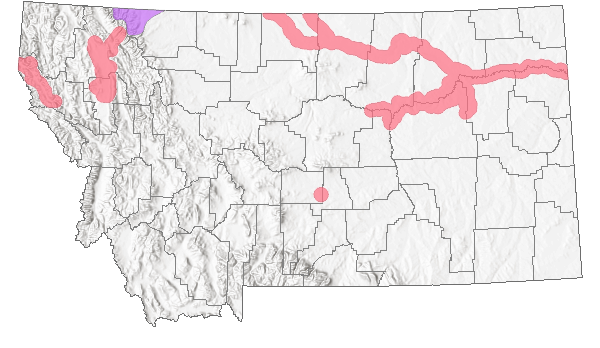 Western Hemisphere Range
Western Hemisphere Range

Range Comments
The Lake Whitefish is native to Montana only in the Saskatchewan River drainage on the east side of Glacier National Park. However, the species has been widely introduced across northern Montana.
Observations in Montana Natural Heritage Program Database
Number of Observations: 613
(Click on the following maps and charts to see full sized version)
Map Help and Descriptions
Relative Density
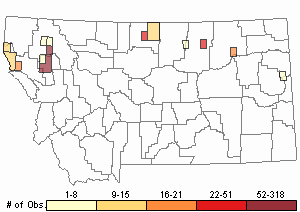
Recency
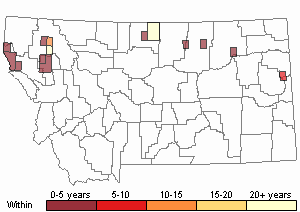
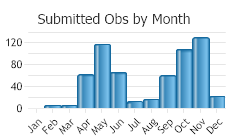
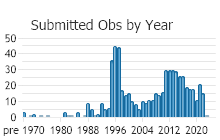
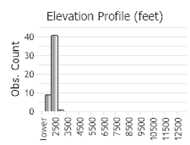 (Observations spanning multiple months or years are excluded from time charts)
(Observations spanning multiple months or years are excluded from time charts)
Habitat
Primarily deep, coldwater lakes where it is found mostly at depths of 50 to 90 feet. Spawns over shallow shoals near shore over rocky or sandy bottom; rarely ascends tributary streams. Has thrived in Fresno Reservoir, a shallow, warm, often turbid reservoir.
Food Habits
Mostly zooplankton during 1st year or 2, and then bottom organisms (Brown 1971). 1981 Flathead Lake study found that zooplankton comprised 50% of April-Nov. diet with organic debris, gastropods, and bryozoans making up 40% (Leathe and Graham 1982)
Ecology
Northern populations typically spawn every 2-3 years.
Reproductive Characteristics
Sexually mature in 4-5 years, some males in 2 years. Spawns Oct-Jan. depending on local conditions. Spawns at night. Eggs broadcast. Incubation: about 1 month at 50 degrees F. (Brown 1971).
Stewardship Responsibility
References
- Literature Cited AboveLegend:
 View Online Publication
View Online Publication Brown, C.J.D. 1971. Fishes of Montana. Bozeman, MT: Big Sky Books/Montana State University. 207 p.
Brown, C.J.D. 1971. Fishes of Montana. Bozeman, MT: Big Sky Books/Montana State University. 207 p. Leathe, S.A. and P.J. Graham. 1982. Flathead Lake fish food habits study. Montana Department of Fish, Wildlife, and Parks. 137 pp.
Leathe, S.A. and P.J. Graham. 1982. Flathead Lake fish food habits study. Montana Department of Fish, Wildlife, and Parks. 137 pp. Lee, D.S., C.R. Gilbert, C.H. Hocutt, R.E. Jenkins, D. E. McAllister, J. R. Stauffer, Jr. 1980. Atlas of North American freshwater fishes. North Carolina State Musuem of Natural History. 867 p.
Lee, D.S., C.R. Gilbert, C.H. Hocutt, R.E. Jenkins, D. E. McAllister, J. R. Stauffer, Jr. 1980. Atlas of North American freshwater fishes. North Carolina State Musuem of Natural History. 867 p. Scott, W.B. and E.J. Crossman. 1973. Rainbow trout, Kamloops trout, Steelhead trout Salmo gairdneri Richardson. pp. 184-191. In: Freshwater fishes of Canada. Ottawa, Canada: Fisheries Research Board of Canada, Bulletin 184. 966 p.
Scott, W.B. and E.J. Crossman. 1973. Rainbow trout, Kamloops trout, Steelhead trout Salmo gairdneri Richardson. pp. 184-191. In: Freshwater fishes of Canada. Ottawa, Canada: Fisheries Research Board of Canada, Bulletin 184. 966 p.
- Additional ReferencesLegend:
 View Online Publication
View Online Publication
Do you know of a citation we're missing? Barnard, D. and J. Vashro. 1986. ASARCo Rock Creek project, baseline fisheries assessment. MTFWP Report under contract to ASARCo. 22 p.
Barnard, D. and J. Vashro. 1986. ASARCo Rock Creek project, baseline fisheries assessment. MTFWP Report under contract to ASARCo. 22 p. Bjorklund, Richard G. 1953. The Lake Whitefish, Coregonus clupeaformis (Mitchill), in Flathead Lake, Montana. M.S. Thesis. University of Montana. Missoula, MT.
Bjorklund, Richard G. 1953. The Lake Whitefish, Coregonus clupeaformis (Mitchill), in Flathead Lake, Montana. M.S. Thesis. University of Montana. Missoula, MT. Craig, V.E. 1952. A story of fish production as it applies to Montana. M.Sc. Thesis. Bozeman, MT: Montana State University. 92 p.
Craig, V.E. 1952. A story of fish production as it applies to Montana. M.Sc. Thesis. Bozeman, MT: Montana State University. 92 p. Elser, A.A. 1967. Fish population of a trout stream in relation to major habitat zones and channel alterations. M.Sc. Thesis. Bozeman, MT: Montana State University. 27 p.
Elser, A.A. 1967. Fish population of a trout stream in relation to major habitat zones and channel alterations. M.Sc. Thesis. Bozeman, MT: Montana State University. 27 p. Joslin, Gayle, and Heidi B. Youmans. 1999. Effects of recreation on Rocky Mountain wildlife: a review for Montana. [Montana]: Montana Chapter of the Wildlife Society.
Joslin, Gayle, and Heidi B. Youmans. 1999. Effects of recreation on Rocky Mountain wildlife: a review for Montana. [Montana]: Montana Chapter of the Wildlife Society. Montana Department of Fish, Wildlife and Parks. 1989. Northeast Montana Warmwater Ecosystem Investigations: project period 7/1/88 through 6/30/89. Proj.# F-46-R-2; Job# V-e. 21p.
Montana Department of Fish, Wildlife and Parks. 1989. Northeast Montana Warmwater Ecosystem Investigations: project period 7/1/88 through 6/30/89. Proj.# F-46-R-2; Job# V-e. 21p. Rahrer, J.F. 1963. Age and growth of four species of fish, Flathead Lake, Montana. M.Sc. Thesis. Bozeman, MT: Montana State University. 16 p.
Rahrer, J.F. 1963. Age and growth of four species of fish, Flathead Lake, Montana. M.Sc. Thesis. Bozeman, MT: Montana State University. 16 p. Schultz, L.P. 1941. Fishes of Glacier National Park, Montana. USDI Conservation Bulletin No. 22. Washington D.C.: US Government Printing Office. 42 p.
Schultz, L.P. 1941. Fishes of Glacier National Park, Montana. USDI Conservation Bulletin No. 22. Washington D.C.: US Government Printing Office. 42 p. Stash, S.W. 2001. Distribution, relative abundance, and habitat associations of Milk River fishes related to irrigation diversion dams. M.Sc. Thesis. Bozeman, MT: Montana State University. 82 p.
Stash, S.W. 2001. Distribution, relative abundance, and habitat associations of Milk River fishes related to irrigation diversion dams. M.Sc. Thesis. Bozeman, MT: Montana State University. 82 p. Weisel, G.F. 1966. Young salmonoid fishes of western Montana. Proceedings of the Montana Academy of Sciences 26:1-21.
Weisel, G.F. 1966. Young salmonoid fishes of western Montana. Proceedings of the Montana Academy of Sciences 26:1-21. Young, B.A., T.L. Welker, M.L. Wildhaber, C.R. Berry, and D. Scarnecchia (eds). 1997. Population structure and habitat use of benthic fishes along the Missouri and Lower Yellowstone Rivers. 1997 Annual report of Missouri River Benthic Fish Study PD-95-5832 to U.S. Army Corps of Engineers and U.S. Bureau of Reclamation. 207 p.
Young, B.A., T.L. Welker, M.L. Wildhaber, C.R. Berry, and D. Scarnecchia (eds). 1997. Population structure and habitat use of benthic fishes along the Missouri and Lower Yellowstone Rivers. 1997 Annual report of Missouri River Benthic Fish Study PD-95-5832 to U.S. Army Corps of Engineers and U.S. Bureau of Reclamation. 207 p. Zymonas, N.D. 2006. Age structure, growth, and factors affecting relative abundance of life history forms of Bull Trout in the Clark Fork river drainage, Montana and Idaho. M.Sc. Thesis. Bozeman, MT: Montana State University. 142 p.
Zymonas, N.D. 2006. Age structure, growth, and factors affecting relative abundance of life history forms of Bull Trout in the Clark Fork river drainage, Montana and Idaho. M.Sc. Thesis. Bozeman, MT: Montana State University. 142 p.
- Web Search Engines for Articles on "Lake Whitefish"
- Additional Sources of Information Related to "Fish"





